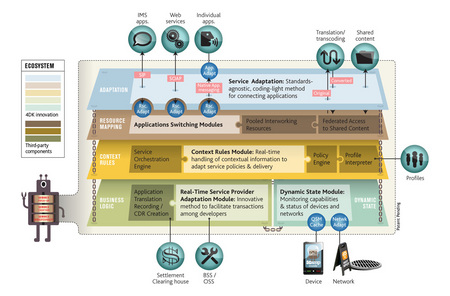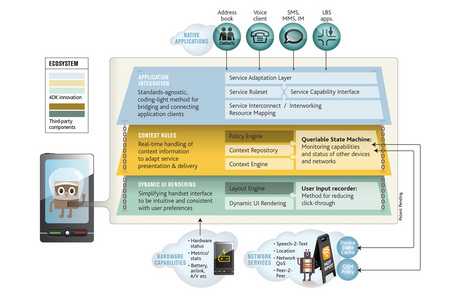Linux powers “mash-up platform” for phones
Mar 12, 2008 — by Eric Brown — from the LinuxDevices Archive — viewsVirginia-based startup 4DK Technologies has used Linux and high-availability middleware to build a “mash-up platform” for wireless carriers offering IP-based services. The “SuperConnectivity” service includes a “Scamp” middleware stack for mobile devices, along with a “Scout” service application built on MontaVista Linux Carrier Grade Edition (CGE) and Enea's Accelerator Platform.
The SuperConnectivity service aims to help carriers market their IP-based services more effectively, by tightening the integration between them. Such services could include VoIP, text-to-speech, transcoding and quality-of-service adaptation, GPS navigation, PTT (push-to-talk), and so on, the company said.
For example, a phone's calendar application could be tied to a GPS navigation service, enabling users to conveniently buy navigational services that guide them to an appointment, the company suggested. At a more basic level, the service could be used to sense when users are driving, and offer them text-to-speech services when text messages arrive. Additional examples include text-to-speech and translation services for instant messages, and “contextual” message delivery options based on GPS location (i.e., forward my incoming VoIP call to a cellular gateway, if I'm not at home).
Mar Tarres, VP of business development, explains, “SuperConnectivity adapts applications and interconnects them based on contextual rules.”
The fact that all the services run on IP (Internet protocol) data services naturally leads 4DK to describe its service as a “mash-up platform” for mobile phone services. The Internet, AJAX, and services such as Google maps have certainly demonstrated the potential value of disaggregating and recombining IP-based network services in new and interesting ways — i.e., “mash-ups.”
Additional touted benefits include the ability to adjust service offerings based on “post-launch” knowledge, and to tie new services in with familiar, well-used services in order to promote adoption and increased service usage. For users, the effect is simplification and convenience, the vendor boasts, with less cutting and pasting between native phone applications and network service interfaces.

Scout (server) function blocks
(Click to enlarge)
As shown in the diagram above, the Scout server component is divided into four layers: Business Logic, Context Rules, Resource Mapping, and sitting on top, Adaptation. Some of the components in the lower layers are supplied by third parties, with 4DK focusing primarily on the web-services savvy Adaptation layer. This top layer connects and combines applications and performs transcoding and translation services.
In the foundational Business Logic layer, 4DK's dynamic state module is said to provide continual monitoring of both status and network, which could, for example, determine that given the available bandwidth and the profile and situation of the receiving handset, a customer should receive a message in text rather than voice, or audio rather than video.

Scamp (client) function blocks
(Click to enlarge)
In the handset, meanswhile, the Scamp middleware phone stack (pictured above) communicates with Scout, informing it of the handset's capabilities, as well as conditions and context, such as whether a customer is driving. Scamp builds upon a Dynamic UI Rendering layer with a Context Rules layer that includes a “queriable state machine” that communicates with Scout. On top is an Application Integration layer that provides functions such as service adaptation.
Initially, 4DK will establish SuperConnectivity as a managed services offering, running its own platform based on the Enea Accelerator Platform's telecom middleware, and Kontron-supplied ATCA blades. Eventually, the plan is to license the technology to wireless carriers and other IP-based services. The entire platform runs on MontaVista Carrier Grade Edition (CGE), according to Tarres.
“We're not only dealing with Web services, but offering voice services, and this needs a level of availability that the typical boxes don't offer,” she said. “So we went with Enea's middleware, which offers high availability and ATCA hardware.”
Accelerating Linux development at Enea
4DK is said to have signed a five-year license agreement with Enea for its “Enea Accelerator Platform,” as well as hiring Enea Professional Services. In recent months, Enea has expanded its Linux service offering, and yesterday, the Swedish firm announced version 3.0 of Element, which is the core middleware component of the Enea Accelerator Platform.
Enea's proprietary RTOS, called OSE, is deployed in the software-defined baseband radios of approximately half of the world's 3G mobile phones and base stations, says the company; yet in recent years, Enea has been increasingly focused on Linux implementations.
Enea's Linux-based Accelerator Platform comprises in-house and third-party products for both ends of the mobile phone market's virtual wire, targeting VoIP, IPTV, broadband Internet, gaming, and streaming video services. Components include:
- Enea's Element high availability (HA) middleware framework
- Enea's Linx inter-process communications (IPC) services
- Enea's Polyhedra high-performance database system
- MontaVista Linux Carrier Grade Edition, which Enea has resold since April 2006
- Tail-f's ConfD software configuration management tools, which Enea integrated earlier this year
Stated Tamara Casey, CEO at 4DK, “Enea's software gives us carrier grade reliability, streamlines the integration with the ATCA system, and provides us with a platform on which we can innovate. We expect the Enea platform to shorten our critical development time by at least six months.”
Availability
4DK did not say when the SuperConnectivity service would be up and running, but Tarres says that the company will have more details to reveal, as well as a demonstration, at this April's CTIA show.
This article was originally published on LinuxDevices.com and has been donated to the open source community by QuinStreet Inc. Please visit LinuxToday.com for up-to-date news and articles about Linux and open source.